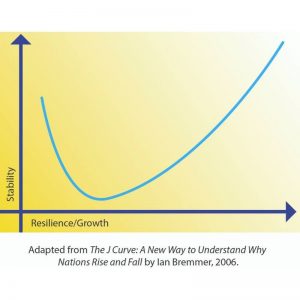“We may not ever understand why we suffer or be able to control the forces that cause our suffering, but we can have a lot to say about what the suffering does to us, and what sort of people we become because of it.” — Rabbi Harold S. Kushner, When Bad Things Happen to Good People
 There is wisdom in the J curve, for it helps us to understand what we experience during times of significant change and disruption.
There is wisdom in the J curve, for it helps us to understand what we experience during times of significant change and disruption.
Note from the diagram that the vertical axis of the J curve is “Stability,” while the horizontal access is “Resilience/Growth.” When change occurs in our lives, the graphic shows that stability begins to decline. When change is significant—a move, the loss of a loved one, the loss of a job, or as now, experiencing a pandemic, the decline in stability can be steep.
One natural reaction to a sudden experience of instability is, “I want to go back. If only I could back to the way things were, everything would be okay.” A second common reaction is “I want this uncertainty to be over NOW—I want to be on the other side of the “J” curve as quickly as possible,” even if it means trying to minimize or deny the significance of what is currently happening.
While these two responses are natural, we soon realize that we can’t go back, and we also cannot force or rush the resolution of what we are going through. There are, fortunately, choices we can make that will significantly affect how deep our J curve experience will be.
We are quite familiar now with the term, “Flatten the curve,” and so here are four specific things we can do to flatten any J curve.
Befriend Solitude: Turn off all your screens and try to spend at least ten minutes each day being still. You might pray, or meditate, or practice mindfulness. Or you might simply sit still and focus on your breathing. If anxious or distracting thoughts arise, just note them and let them pass, as if you were sitting on a riverbank watching a leaf float by until it eventually floats out of sight. The mindfulness app Headspace has free meditations available now that are easy to access.
Connect With Others: We know that distancing ourselves from others flattens the pandemic curve. Making time each day to connect with others helps to flatten the J curve. Fortunately, there are many options for connecting with others. Use the ones that work for you. Connect with at least one person or more for at least fifteen minutes each day. If you are living with others at this time, make intentional time each day to meaningfully connect with each person in your household.
Nurture Your Spirituality: Nurturing your spirituality is crucial for supporting your journey through change and disruption. If you are a praying person, pray. If you are a religious person, deepen your practice of your faith. When possible, spend time in nature. Read poetry. Listen to music. Do whatever feeds your spirit.
Offer Kindness to Others: Offer one act of kindness to others each day. Call someone who is alone. Call someone who is grieving. Donate to a group that is helping others. Give a larger tip if you do takeout from a restaurant. My daily runs benefit from the kindness of children who use chalk to regularly write words of encouragement for those passing by on the sidewalks in front of their homes
Every one of us is experiencing some degree of change and instability, some degree of a J curve right now. None of us planned for or chose this particular pandemic J curve. We can, however, make choices that will help to flatten the curve by practicing the things I have outlined here.
Article by The Rev. Dr. D. Scott Stoner, Living Compass

